
Messier 38 or M38, also known as NGC 1912 or Starfish Cluster, is an open cluster of stars in the constellation of Auriga. It was discovered by Giovanni Batista Hodierna before 1654 and independently found by Le Gentil in 1749. The open clusters M36 and M37, also discovered by Hodierna, are often grouped together with M38. Distance is about 1.066 kpc (3,480 ly) away from Earth. The open cluster NGC 1907 lies nearby on the sky, but the two are most likely just experiencing a fly-by, having originated in different parts of the galaxy.

Messier 39 or M39, also known as NGC 7092, is an open cluster of stars in the constellation of Cygnus, positioned two degrees to the south of the star Pi Cygni and around 9° east-northeast of Deneb. The cluster was discovered by Guillaume Le Gentil in 1749, then Charles Messier added it to his catalogue in 1764. When observed in a small telescope at low power the cluster shows around two dozen members but is best observed with binoculars. It has a total integrated magnitude (brightness) of 5.5 and spans an angular diameter of 29 arcminutes – about the size of the full Moon. It is centered about 1,010 light-years away.

NGC 6193 is open cluster containing 27 stars in the constellation Ara, visible to the unaided eye. NGC 6193 lies at the center of the Ara OB1 association, which extends over a square degree. The cluster is associated with neighboring regions of the nebulosity NGC 6188.
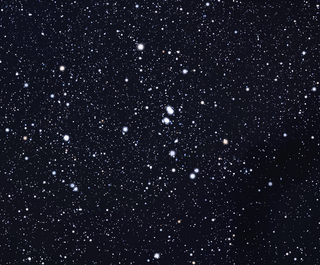
NGC 6871 is a small, young open cluster in the constellation of Cygnus. The cluster has fewer than 50 members, most of which are blue and white stars. It is located 5135 light-years from Earth.

NGC 1342 is an open cluster in the constellation Perseus. It was discovered by William Herschel on 28 December 1799. It is located in the south of the constellation, almost halfway between Algol and ζ Persei, away from the plane of the Milky Way. NGC 1342 has an apparent size of 17' and an apparent magnitude of 6.7, marginally visible by naked eye. In 1994, Peña, J. H. and Peniche, R. estimated by the use of photometric data, that the age of the cluster is 400 million years.
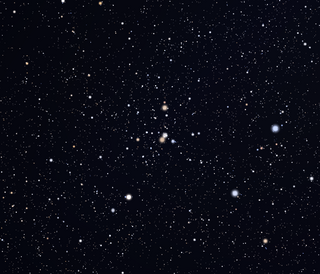
NGC 1545 is an open cluster in the constellation Perseus. It was discovered by William Herschel on December 28, 1790. It is located in the north-eastern part of the constellation, a few arcminutes east of the 4.5 magnitude star b Persei, near the equally large and bright NGC 1528, which is less than 1.5° towards the northwest. However, it is less dense and rich. The brightest star of the cluster is a K5 III giant star, with 7.1 magnitude, but its membership is questionable. One more 7.9 magnitude star is visible at the north edge of the cluster.
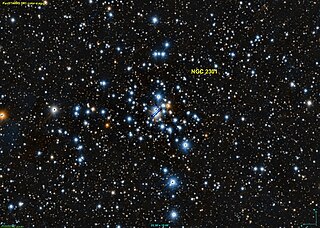
NGC 2301 is an open cluster in the constellation Monoceros. It was discovered by William Herschel in 1786. It is visible through 7x50 binoculars and it is considered the best open cluster for small telescopes in the constellation. It is located 5° WNW of delta Monocerotis and 2° SSE of 18 Monocerotis. The brightest star of the cluster is an orange G8 subgiant star of 8.0 magnitude, but it is possible that it is a foreground star. The cluster contains also blue giants. The brightest main sequence star is a B9 star with magnitude 9.1.

NGC 6380 is a globular cluster located in the constellation Scorpius. It was originally discovered by James Dunlop in 1826, and he named it Dun 538. Eight years later, in 1834, it was independently rediscovered by John Herschel and he named it H 3688. The cluster was re-rediscovered in 1959 by Paris Pişmiş, who catalogued it as Tonantzintla 1 — and referred to it as Pişmiş 25. Until the 1950s NGC 6380 was thought to be an open cluster. It was A. D. Thackeray who realised that it was in fact a globular cluster. Nowadays, this cluster is reliably recognised in widely available catalogues as a globular cluster, and referred to simply as NGC 6380.

NGC 1901 is an open cluster in the Dorado Constellation. It has a bright middle and is a little rich, with stars from 7th magnitude downwards. The celestial object was discovered on 30 December 1836 by the British astronomer John Herschel. The cluster is sparsely populated with GAIA data suggesting a membership of around 80 stars. It is considered unlikely it will survive its next pass through the Milky Way’s galactic plane in about 18 million years time.

NGC 146 is a small open cluster in the constellation Cassiopeia. It was discovered by John Herschel in 1829 using his father's 18.7 inch reflecting telescope.

NGC 6939 is an open cluster in the constellation Cepheus. It was discovered by William Herschel in 1798. The cluster lies 2/3° northwest from the spiral galaxy NGC 6946. The cluster lies approximately 4,000 light years away and it is over a billion years old.
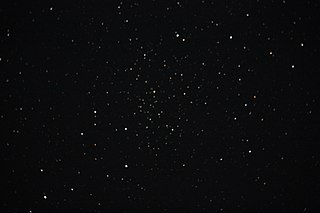
NGC 6940 is an open cluster in the constellation Vulpecula. It was discovered by William Herschel in 1784. The cluster is nearly a billion years old and it is located 2,500 light years away. It is considered the finest open cluster in the constellation.

NGC 7209 is an open cluster in the constellation Lacerta. It was discovered by William Herschel on 19 October 1787. The cluster lies 3,810 light years away from Earth. It has been suggested that there is another cluster at a distance of 2,100 light years projected in front of a cluster lying at 3,800 light years away, based on the reddening of the cluster, however, further photometric studies of the cluster did not support that claim.

IC 2395 is an open cluster in the constellation Vela.
NGC 5662 is an open cluster in the constellation Centaurus. It was discovered by Nicolas Louis de Lacaille on May 17, 1752 from South Africa. James Dunlop observed it on July 10, 1826 from Parramatta, Australia and added it to his catalog as No. 342.

NGC 5316 is an open cluster in the constellation Centaurus. It was discovered by James Dunlop in 1826. Located approximately 4,000 light years away from Earth, it is located in the Carina-Sagittarius arm.

NGC 1987 is an open cluster or a globular cluster located in the Mensa constellation and part of the Large Magellanic Cloud. It was discovered by John Herschel on November 3, 1834. Its apparent magnitude is 12.1, and its size is 1.7 arc minutes. It is thought to be around 600 million years old and has a significant number of red ageing stars.

NGC 1955 is an open cluster associated with an emission nebula located in the Dorado constellation. This nebula is part of the H II region which is part of the Large Magellanic Cloud and was discovered by James Dunlop on August 3, 1826. Its apparent magnitude is 9.0, and its size is 1.8 arc minutes.
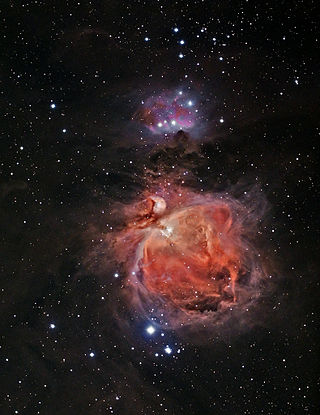
NGC 1981 is an open cluster which is located in the Orion constellation. It was discovered by John Herschel on 4 January 1827. Its apparent magnitude is 4.2 and its size is 28.00 arc minutes. It lies to the north of the Orion Nebula, separated from it by the Sh2-279 region containing NGC 1973, 1975, and 1977.
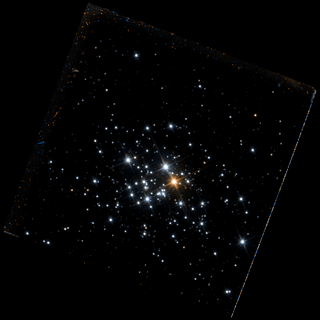
NGC 1984 is an open cluster associated with an emission nebula, it is located in the constellation Dorado in the Large Magellanic Cloud. It was discovered by John Herschel on 16 December 1835. The apparent magnitude is 9.9 and its size is 1.50 by 1.20 arc minutes.



















